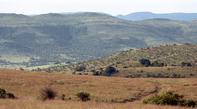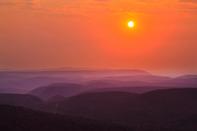Discovery of this Climbing Mecca
The first kloof in the Magaliesberg to be visited by climbers was deep Tonquani, named after Tenquaan, chief of the Bakhatla tribe that took refuge here from Mzilikazi.

Harry Barker, a founder member of the MCSA (Mountain Club of South Africa) and Dick Barry, opened some of the best climbing routes in Tonquani. The well-trodden paths of the popular kloofs must now seem strange to a man who saw leopard, lynx and their cubs melting into the tangled bush before him and buck scattering at his approach.
Harry Barker was responsible for giving most of the kloofs their modern names, as it was he and his companions who in the 1930s explored the mazes and discovered this climbing mecca. Retief's, Grobelaar's and some others were named after the farmers on whose land it was situated.
Mhlabatini Kloof means 'the place of white sands', while Trident was the obvious name for a kloof with a triple fork. Aptly enough, it was Barker who in 1968 finally traced the last kloof in the range and named it Hidden Kloof.
Magaliesberg Range
The Magaliesberg range was named after Chief Mohale who, with his tribe, sought refuge from Mzilikazi in its sheltering folds. On his bloody path to becoming king of the Matabele nation, the renegade Zulu chief Mzilikazi swept across the Transvaal interior early in the 19th-century, mercilessly conquering all the tribes he encountered en route. Playing his own significant part in the Difaqane Wars, Mzilikazi helped to devastate a pastoral existence that had thrived for centuries.
Secret Pathways
The Second Anglo-Boer War brought its own pressures to bear on the area. It was the scene of many campaigns and, during the final stages, a focus of action when the Boers launched guerrilla raids to the south from the Bushveld between the Magaliesberg and Waterberg ranges. They used secret pathways to cross the Magaliesberg and at places such as Trident Kloof hikers may still come upon the remains of concealed Boer camps.
Some of the British blockhouses that were built to restrict the movements of the commandos still stand. As part of their plan to counter Boer resistance, these same blockhouses, built from the Magaliesberg's age-old rock, helped enforce the scorched earth policy of the British, when Boer farms were razed to the ground. The blockhouses remain, sterile intrusions of a short-lived dynasty, but once more the area produces peaches, oranges, flowers, cattle and a variety of vegetables to feed the hungry machine of nearby industry and commerce.
Valleys Around the Magaliesburg

The Boers who settled in the valleys around the Magaliesburg and Waterberg turned them into one of the most productive farming areas the country had known. Apricots, peaches and citrus fruits from here fetched high prices on the Kimberley diamond fields and, even after the long wagon trip; a Magaliesburg orange was an expensive treat at the coast. The legendary Oom Schalk Lourens of Herman Charles Bosman's Marico Tales savoured Magaliesberg tobacco as reputedly the finest in the land.
Magaliesburg citrus is still celebrated at the annual Citrus Festival, visitors get the opportunity to taste and buy the most delectable citrus nectars from a variety of produce and products for really good prices. The festival is also known for the ‘Sitrusmampoer’ alcohol that comes in a variety of beverages from shooters to liqueur.